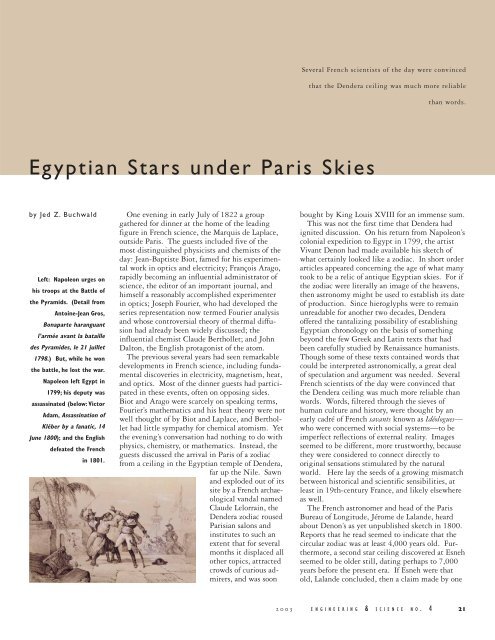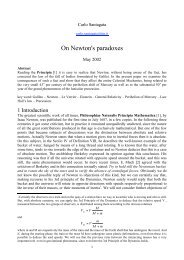Egyptian Stars under Paris Skies - Engineering & Science - Caltech
Egyptian Stars under Paris Skies - Engineering & Science - Caltech
Egyptian Stars under Paris Skies - Engineering & Science - Caltech
Create successful ePaper yourself
Turn your PDF publications into a flip-book with our unique Google optimized e-Paper software.
Several French scientists of the day were convinced<br />
that the Dendera ceiling was much more reliable<br />
than words.<br />
<strong>Egyptian</strong> <strong>Stars</strong> <strong>under</strong> <strong>Paris</strong> <strong>Skies</strong><br />
by Jed Z. Buchwald<br />
Left: Napoleon urges on<br />
his troops at the Battle of<br />
the Pyramids. (Detail from<br />
Antoine-Jean Gros,<br />
Bonaparte haranguant<br />
l’armée avant la bataille<br />
des Pyramides, le 21 juillet<br />
1798.) But, while he won<br />
the battle, he lost the war.<br />
Napoleon left Egypt in<br />
1799; his deputy was<br />
assassinated (below: Victor<br />
Adam, Assassination of<br />
Kléber by a fanatic, 14<br />
June 1800); and the English<br />
defeated the French<br />
in 1801.<br />
One evening in early July of 1822 a group<br />
gathered for dinner at the home of the leading<br />
figure in French science, the Marquis de Laplace,<br />
outside <strong>Paris</strong>. The guests included five of the<br />
most distinguished physicists and chemists of the<br />
day: Jean-Baptiste Biot, famed for his experimental<br />
work in optics and electricity; François Arago,<br />
rapidly becoming an influential administrator of<br />
science, the editor of an important journal, and<br />
himself a reasonably accomplished experimenter<br />
in optics; Joseph Fourier, who had developed the<br />
series representation now termed Fourier analysis<br />
and whose controversial theory of thermal diffusion<br />
had already been widely discussed; the<br />
influential chemist Claude Berthollet; and John<br />
Dalton, the English protagonist of the atom.<br />
The previous several years had seen remarkable<br />
developments in French science, including fundamental<br />
discoveries in electricity, magnetism, heat,<br />
and optics. Most of the dinner guests had participated<br />
in these events, often on opposing sides.<br />
Biot and Arago were scarcely on speaking terms,<br />
Fourier’s mathematics and his heat theory were not<br />
well thought of by Biot and Laplace, and Berthollet<br />
had little sympathy for chemical atomism. Yet<br />
the evening’s conversation had nothing to do with<br />
physics, chemistry, or mathematics. Instead, the<br />
guests discussed the arrival in <strong>Paris</strong> of a zodiac<br />
from a ceiling in the <strong>Egyptian</strong> temple of Dendera,<br />
far up the Nile. Sawn<br />
and exploded out of its<br />
site by a French archaeological<br />
vandal named<br />
Claude Lelorrain, the<br />
Dendera zodiac roused<br />
<strong>Paris</strong>ian salons and<br />
institutes to such an<br />
extent that for several<br />
months it displaced all<br />
other topics, attracted<br />
crowds of curious admirers,<br />
and was soon<br />
bought by King Louis XVIII for an immense sum.<br />
This was not the first time that Dendera had<br />
ignited discussion. On his return from Napoleon’s<br />
colonial expedition to Egypt in 1799, the artist<br />
Vivant Denon had made available his sketch of<br />
what certainly looked like a zodiac. In short order<br />
articles appeared concerning the age of what many<br />
took to be a relic of antique <strong>Egyptian</strong> skies. For if<br />
the zodiac were literally an image of the heavens,<br />
then astronomy might be used to establish its date<br />
of production. Since hieroglyphs were to remain<br />
unreadable for another two decades, Dendera<br />
offered the tantalizing possibility of establishing<br />
<strong>Egyptian</strong> chronology on the basis of something<br />
beyond the few Greek and Latin texts that had<br />
been carefully studied by Renaissance humanists.<br />
Though some of these texts contained words that<br />
could be interpreted astronomically, a great deal<br />
of speculation and argument was needed. Several<br />
French scientists of the day were convinced that<br />
the Dendera ceiling was much more reliable than<br />
words. Words, filtered through the sieves of<br />
human culture and history, were thought by an<br />
early cadré of French savants known as Idéologues—<br />
who were concerned with social systems—to be<br />
imperfect reflections of external reality. Images<br />
seemed to be different, more trustworthy, because<br />
they were considered to connect directly to<br />
original sensations stimulated by the natural<br />
world. Here lay the seeds of a growing mismatch<br />
between historical and scientific sensibilities, at<br />
least in 19th-century France, and likely elsewhere<br />
as well.<br />
The French astronomer and head of the <strong>Paris</strong><br />
Bureau of Longitude, Jérome de Lalande, heard<br />
about Denon’s as yet unpublished sketch in 1800.<br />
Reports that he read seemed to indicate that the<br />
circular zodiac was at least 4,000 years old. Furthermore,<br />
a second star ceiling discovered at Esneh<br />
seemed to be older still, dating perhaps to 7,000<br />
years before the present era. If Esneh were that<br />
old, Lalande concluded, then a claim made by one<br />
2003<br />
ENGINEERING & SCIENCE NO. 4<br />
21




